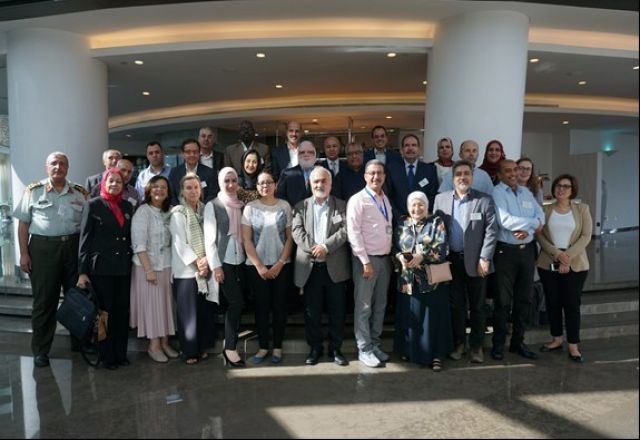 Attendants of the Regional Meeting on Poliovirus Surveillance among Primary Immunodeficiency Patients in the Eastern Mediterranean Region, 28 – 30 October 2019, Amman, Jordan. ©WHO/EMRO
Attendants of the Regional Meeting on Poliovirus Surveillance among Primary Immunodeficiency Patients in the Eastern Mediterranean Region, 28 – 30 October 2019, Amman, Jordan. ©WHO/EMRO
20 February 2020 – In line with the Strategic Advisory Group of Experts (SAGE) recommendation and the Global Strategic Surveillance Action Plan 2018-2020, WHO EMRO and GPEI partners conducted the Regional Meeting on Poliovirus Surveillance among Primary Immunodeficiency Patients (PIDs) between 28-30 October 2019 in Amman, Jordan.
The meeting aimed to develop national plans for PID surveillance and identify next steps to roll out PID surveillance in selected countries. The lessons learnt from phase I implementation of the project will be used to implement PID surveillance elsewhere.
Dr Hamid Jafari, Director for Polio Eradication at WHO/EMRO, joined the opening session, and welcomed delegates from the four countries attending the meeting: the Arab Republic of Egypt, the Islamic Republic of Iran, the Republic of Tunisia, and the Hashemite Kingdom of Jordan. He also welcomed facilitators from WHO/HQ and partners from the US Centers for Disease Control and Prevention (CDC) and the Bill & Melinda Gates Foundation (BMGF), expressing his appreciation towards their efforts in polio eradication.
The countries were selected based on a Global Risk Assessment considering several risk factors for PIDs including: Consanguinity, occurrence of immuno-deficiency associated vaccine-derived poliovirus (iVDPV), oral polio vaccine (OPV) immunization rates, PID survival rate, previous experience with and inclusion in study projects, and experience with antiviral drug use.
PIDs are a group of up to 350 known diseases, which are caused by genetic defects of the immune system. A few types of PIDs are known to be associated with risk of prolonged excretion of viruses and subsequently their spread. This is a real threat for the polio programme after eradication, as children will become more vulnerable to infection with polio as immunity levels wane after cessation of polio vaccination. If polio is no longer present in the wild, this is not a problem, but if virus is unintentionally reintroduced to the environment by a PID patient, cases of paralysis could occur once again.
Dr Jafari noted that the significance of immune deficiency-related vaccine-derived polioviruses (iVDPV) has been recognized for several years. Treating those with PIDs is an important component of the 2019 – 2023 Endgame Strategy for the Global Polio Eradication Initiative.
Discussion at the meeting focused on reviewing the current situation of survey-based PID surveillance in the region. Countries presented their experience of antiviral introduction policies, mapped ways to ensure sensitive high-quality surveillance systems, and identified the next steps for effective operationalization of PID surveillance. The intention was to propose a public health response that reduces both individual risk of developing poliomyelitis and the risk to the community of poliovirus transmission. The Regional Office demonstrated a developed information system to support implementation of PID surveillance in the four countries at the meeting.
Key actions were agreed by countries, the WHO regional office, and the Global Working Group to complete over the coming months.
This is just the beginning of a long-term project to consider the needs of PID patients and their communities. By building strong relationships between different involved parties, progress can be made to detect and protect PID patients now and ensure that sturdy foundations are laid for supporting patients after the certification of polio eradication.
For more information on the discussions and outcomes of the meeting, please contact Dr. Muhammad Obaid-ul Islam Butt, Medical Officer for Surveillance, at buttmu[AT]who[DOT]int, or Dr. Ashraf Wahdan, Medical Officer for Certification and PID focal point, at wahdana[AT]who[DOT]int.


